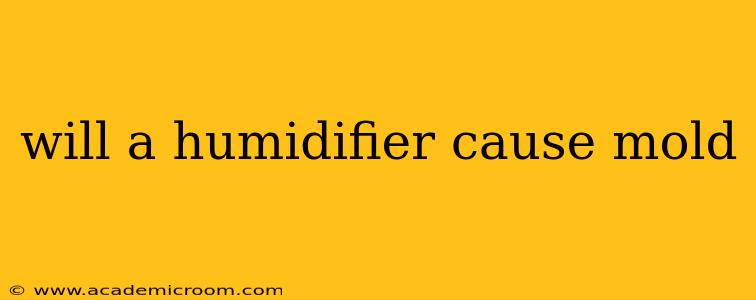Will a Humidifier Cause Mold? Understanding the Risks and Prevention
Humidifiers are fantastic for combating dry air, especially during winter months. However, a common concern is whether using a humidifier increases the risk of mold growth in your home. The answer is complex: a humidifier itself doesn't cause mold, but it can certainly create conditions that are more favorable for mold growth if not properly maintained. Let's delve into the details.
How Can a Humidifier Contribute to Mold Growth?
The primary way a humidifier contributes to mold growth is by increasing the moisture level in the air. Mold spores are virtually everywhere, and they need moisture to germinate and grow. A humidifier increases the ambient humidity, providing the necessary moisture for these spores to thrive, particularly in areas with poor ventilation. Think of it like this: mold spores are seeds; humidity is the water that helps them sprout.
What Types of Humidifiers Pose the Greatest Risk?
Different types of humidifiers present varying levels of mold risk:
-
Cool-mist humidifiers: These are generally considered safer than warm-mist humidifiers, but they still require diligent cleaning to prevent mold growth. The water reservoir in these humidifiers is a breeding ground for mold if not properly cleaned and maintained regularly.
-
Warm-mist humidifiers: These humidifiers, due to the heating element, can potentially scald mold spores, reducing the risk somewhat. However, mineral deposits from the water can build up and create a favorable environment for mold growth.
-
Ultrasonic humidifiers: These use ultrasonic vibrations to create a fine mist. While they tend to be quieter than other types, they can still create ideal conditions for mold, especially if the water isn't changed frequently and the unit isn't cleaned regularly.
What are the Signs of Mold Growth in a Humidifier?
Recognizing mold growth in your humidifier is crucial for preventing its spread. Look out for these signs:
-
Visible mold: This is the most obvious sign. Look for fuzzy, slimy, or discolored patches inside the humidifier tank or on the filter.
-
Musty odor: A musty or mildew smell emanating from the humidifier is a strong indicator of mold growth.
-
Reduced efficiency: If your humidifier isn't producing as much moisture as it used to, it could be due to mold buildup restricting airflow.
How Can I Prevent Mold Growth in My Humidifier?
Preventing mold growth is far easier than dealing with it. Follow these steps:
-
Regular cleaning: Clean your humidifier thoroughly according to the manufacturer's instructions. This usually involves emptying the water tank, cleaning all parts with a mild solution of soap and water, and rinsing thoroughly. Allow parts to air dry completely before reassembling.
-
Use distilled or filtered water: Tap water contains minerals that can contribute to mineral buildup and mold growth. Using distilled or filtered water minimizes this risk.
-
Empty and dry the tank daily: Even if you're not using the humidifier daily, emptying and drying the tank prevents mold from forming.
-
Proper ventilation: Ensure good ventilation in the rooms where you use the humidifier to prevent moisture buildup.
What if I already have mold in my humidifier?
If you discover mold in your humidifier, do not attempt to just wipe it away. Thoroughly clean the unit using a solution of bleach and water (always follow safety precautions when using bleach). If the mold is extensive or you're unsure how to effectively clean it, consider replacing the humidifier altogether.
By following these preventative measures, you can minimize the risk of mold growth associated with using a humidifier and enjoy the benefits of comfortable humidity in your home. Remember, a clean humidifier is a safe humidifier.
